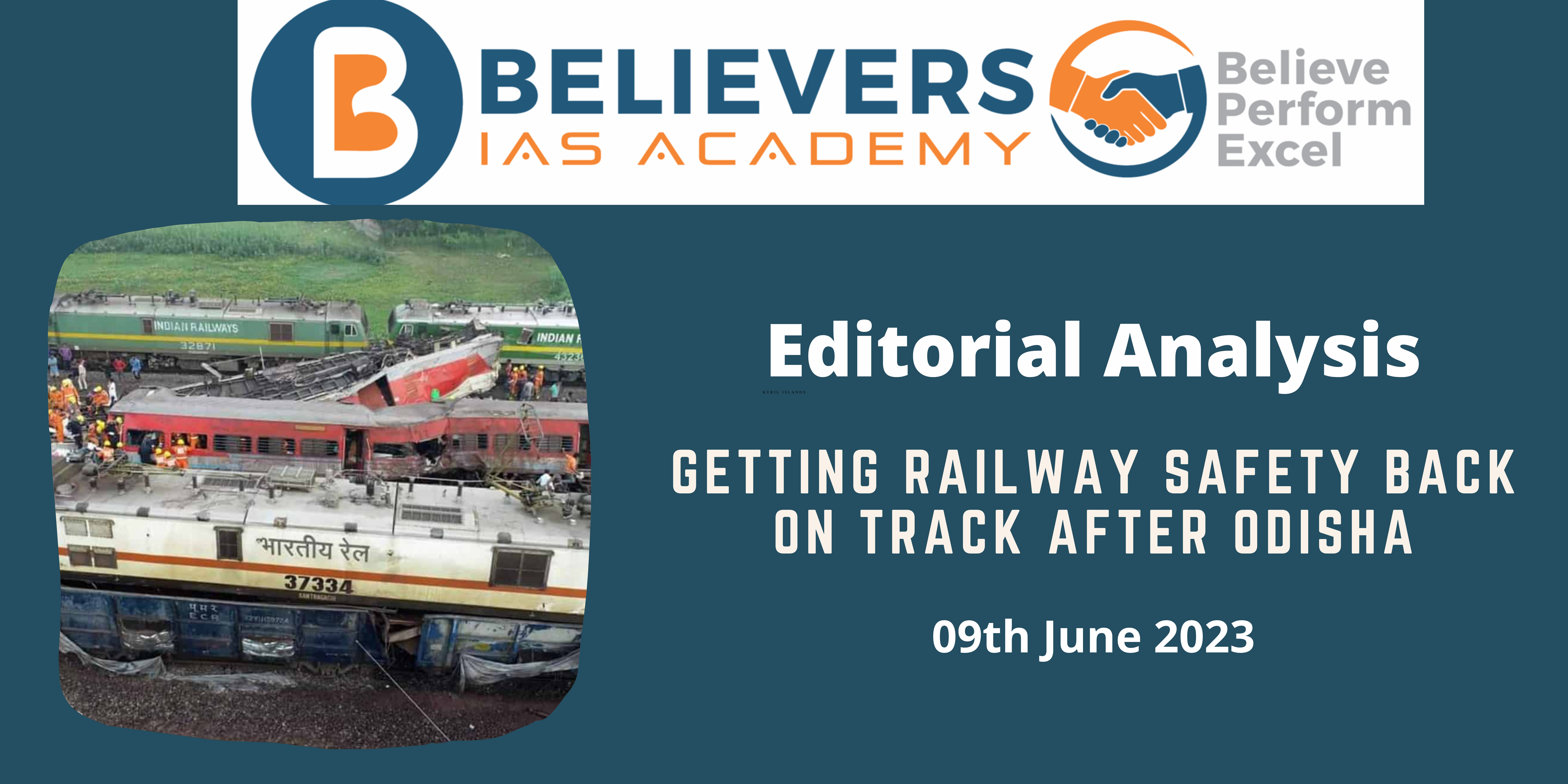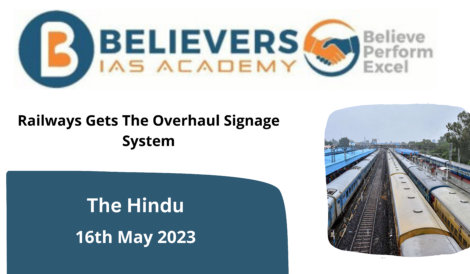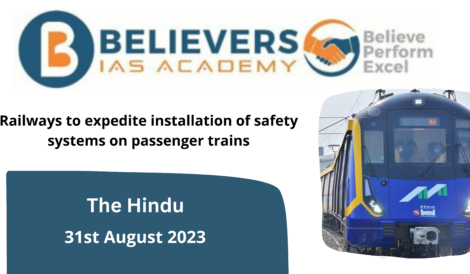Getting railway safety back on track after Odisha
Context :
After a train accident involving the 12841 Shalimar-Chennai Coromandel Express, the 12864 Sir M. Visvesvaraya Terminal Bengaluru-Howrah Superfast Express, and a goods train on June 2 in the Balasore district of Odisha, there have been countless television debates. However, the crucial question of how the Indian Railways might work to ensure that such catastrophes are never repeated is one that many panellists have been unable to answer persuasively, aside from the usual clichés.
Odisha Train Tragedy
- Details of the Accident: Two express trains and a goods train were involved in the accident, which happened in the Balasore district of Odisha. The Yashwantpur-Howrah Express’s two carriages derailed close to the Bahanaga train station, colliding with the Coromandel Express as it approached. As a result, roughly 17 coaches derailed, some of which collided with a freight train’s waggons.
- Casualties: Over 350 people were hurt in the collision, and at least 70 passengers were thought dead. As victims were being pulled out from under the derailed carriages, it was anticipated that the death toll would grow.
- Accident Cause: The incident’s precise cause was not discovered immediately. To ascertain the cause, railway officials were awaiting the results of preliminary investigations.
- Earlier Mishap: This mishap was rated as one of the worst in recent memory. It is mentioned that the Coromandel Express also experienced an accident in 2013, which occurred in the Jajpur district, around 50 kilometres from the current disaster scene.
- Government Response: The Odisha government deployed multiple teams, including senior Secretaries and a Minister, to manage the situation. Doctors from neighbouring districts and premier medical colleges were mobilized to provide medical assistance to the injured.
- Assistance and Reactions: Prime Minister Narendra Modi, Odisha Chief Minister Naveen Patnaik, and West Bengal Chief Minister Mamata Banerjee expressed grief over the accident. The Railways Minister announced compensation for the deceased and injured. Tamil Nadu Chief Minister M.K. Stalin dispatched a team to aid Tamils affected by the accident and promised necessary assistance.
- Coordination: To coordinate with railway officials and the Odisha government in providing rescue and relief to the affected passengers, the West Bengal government dispatched a delegation consisting of a Minister and an MP.
Possible reasons for this accident
- Enhancing Access Control: The event made clear the necessity for more robust protections against unauthorised access and interference with train signalling systems. Implementing several digital authorizations to access equipment and limiting the physical movement of staff members who aren’t authorised maintainers could be one approach. To increase security, this would necessitate investigating cutting-edge technology and utilising mobile devices and IT applications.
- Safety culture and training: Fostering a safety culture within the Indian Railways is essential, with a focus on the value of adhering to protocols and procedures. All railway employees, including maintainers and signal operators, should get the proper training and awareness programmes to ensure that they are aware of the potential repercussions of their actions and the importance of their duties in guaranteeing passenger safety.
- Strict Accountability: If the inquiry finds that the maintainer’s unsafe entry or shortcuts caused the accident, it is crucial to establish if these occurrences were one-offs or a pattern throughout the zone. Individuals who are found to be at fault should face harsh punishment, and high management should be held responsible for oversight and enforcement of safety measures failings.
- The Indian Railways should give upgrading the infrastructure for track and signalling systems priority. Investments in cutting-edge systems and technologies, like the Kavach complete signalling system, can improve rail safety and expand the number of trains that can run simultaneously. Track and signalling projects must be completed more quickly and with enough financing to ensure safer operations.
- Continuous Monitoring and Auditing: It is crucial to regularly monitor, audit, and inspect railway equipment, operational procedures, and infrastructure to spot possible risks and take immediate action to remedy them. Putting in place a reliable system for documenting and investigating near-misses and safety occurrences can give important information for anticipatory safety improvements.
- Collaboration and International Best Practices: The Indian Railways can benefit from understanding what is done internationally to ensure the safety of trains. Collaboration with well-known international railway operators and organisations can aid in knowledge acquisition and the use of successful tactics to raise safety standards.
Effective ways to tackle similar incidents:
- Establish a comprehensive maintenance programme that includes routine inspections of rails, switches, bridges, and other infrastructure elements. Regular maintenance and inspection. Defects like worn-out rails or broken switches can be found and fixed to avoid potential derailments.
- modernised monitoring techniques Use cutting-edge technologies to continuously check the state of the tracks, such as track geometry vehicles and wayside monitoring systems. By spotting anomalies like track misalignment or excessive wear, these technologies enable prompt maintenance and lower the danger of derailments.
- Set appropriate speed limits based on the condition of the tracks, curves, and gradients. Speed restrictions are particularly important in areas with known vulnerabilities or temporary track conditions, such as construction zones or areas prone to landslides.
- Install and maintain a robust signalling system to ensure clear and accurate communication between trains, trackside equipment, and dispatchers. This can help prevent collisions, provide warnings about track conditions, and facilitate prompt response in case of emergencies.
- Establish a comprehensive maintenance programme that includes routine inspections of rails, switches, bridges, and other infrastructure elements. Regular maintenance and inspection. Defects like worn-out rails or broken switches can be found and fixed to avoid potential derailments.
- modernised monitoring techniques Use cutting-edge technologies to continuously check the state of the tracks, such as track geometry vehicles and wayside monitoring systems. By spotting anomalies like track misalignment or excessive wear, these technologies enable prompt maintenance and lower the danger of derailments.
- PTC systems use advanced technology, such as GPS and computer algorithms, to monitor and control train movements. They can automatically intervene to prevent overspeeding, unauthorised entry into work zones, or train collisions, significantly reducing the risk of derailments.
- Identify and mitigate human factors that can contribute to derailments, such as fatigue management programs for train operators, adherence to safety protocols, and effective communication between crew members.
Similar Topics
Railways Gets The Overhaul Signage System




